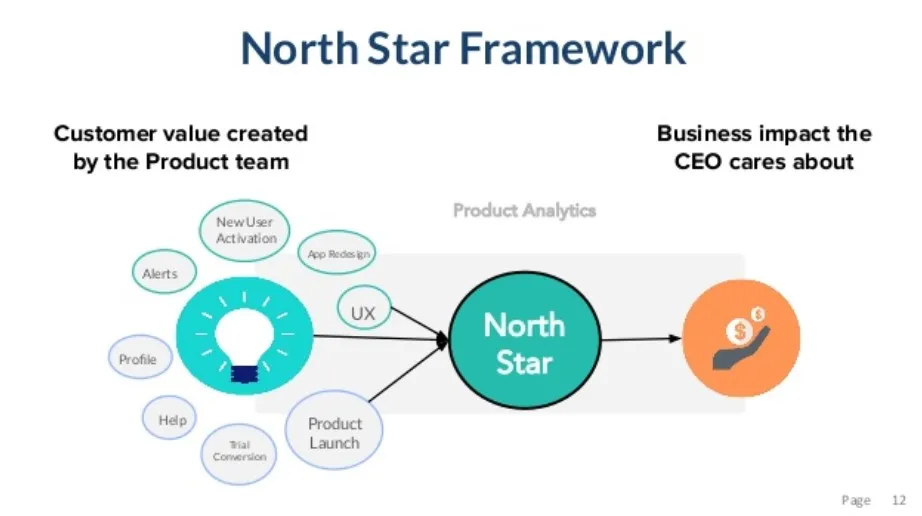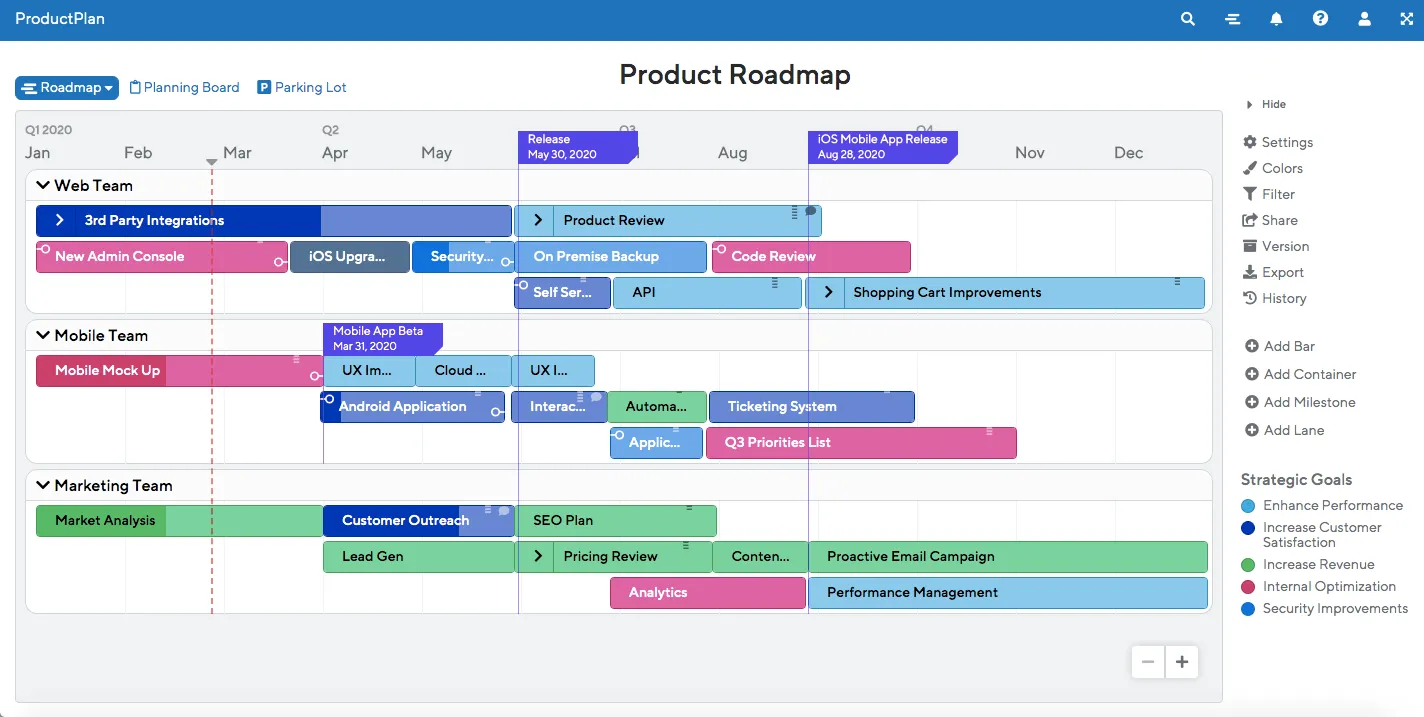Feature-Less Product Roadmapping Can Benefit Your Product

The traditional product roadmap consists of two main ingredients: Features and dates. Here’s what we’re going to build, and this is when it’s going to be ready.
With the traditional roadmap, audiences can easily see if it contains the things they care about and when they’ll be available. The marketing team can gear up their communication strategies and start tying product launch announcements to key events and marketing campaigns. The sales team can start making promises to prospects to win more deals, and the product development team can start making plans for implementation and scheduling resources.
It all seems like a pretty good approach to planning out your products. You have a detailed, predictable look into the next six-to-24 months, and there’s a level of certainty that puts everyone at ease.
A roadmap that lists the features you’re going to build and estimated times of arrival works well for many organizations, but there is another way to approach road mapping, and it might be a better fit for you and your company.
In this post, we discuss the feature-less roadmap and look at both its pros and cons and why it could potentially work for your product.
Table of Contents
Product Roadmapping: Introducing the Feature-Less Roadmap
A feature-less roadmap communicates the upcoming plans for the product without simply listing a bunch of features in chronological order. It replaces the specificity of a schedule and particular deliverables with a broader strategic view of things.
Typically, a feature-less roadmap is based on themes or outcomes that are driven by KPIs or a North Star metric, which drives the product strategy. These roadmap elements are far less specific than a feature-based roadmap – much like a user story in agile is far less detailed than a product requirements document in a waterfall environment.

When it comes to creating a feature-less roadmap, it’s important that you don’t list every feature on the roadmap. Instead, you should focus on the features during the actual implementation process. In doing so, your team can drive outcomes without being too distracted by the minute details.
For example, a traditional roadmap might list handling credit card transactions, accepting PayPal, integrating with a third-party payment platform, storing payment methods for future transactions, sending receipts, etc. On the other hand, a feature-less roadmap would include “Payment” as a roadmap theme.
This, however, doesn’t mean that all these items won’t get built. It simply means that the development team isn’t locked into doing them all or building them in a specific order and stating when each of them will be ready.
Instead, product management and product development will work together during the process to work out those details as they go. Both approaches meet the final goal of accepting payments. The nuances are simply left off of the feature-less roadmap because they don’t matter to the majority of stakeholders viewing it.
Freed from Features: Product Roadmapping That Tells a Story
When the roadmap is freed from features, it is no longer constrained and is primed for storytelling and articulating the product’s strategy.
This paints the story in broad strokes. It eschews the details for general themes and prioritized outcomes. It elevates the discussion above minutiae like “when will I be able to import contacts from Salesforce.com” and transforms it into one dealing with fundamental directions the product is taking and major milestones.
These kinds of roadmaps foster stakeholder alignment, motivate the team, generate excitement, and convey the product vision to investors, coworkers, and customers. Instead of checking items off a wish list, goals, outcomes, and metrics become the currency of conversation.
Of course, this doesn’t mean features don’t exist. As implementation of different themes and phases begins, teams should, for the most part, have already nailed down what they’re going to build.
When those things firm up, they can be shared with relevant parties who will need to understand what’s coming so they can adequately price, position, market, and sell it. Likewise, there will eventually be release dates, but they don’t necessarily belong on the actual roadmap. If you need to visualize dates on your roadmap, leverage milestones for key deadlines and releases.
Is Feature-Less Product Roadmapping Right for Your Product?
Moving to a feature-free roadmap isn’t for everyone. Before making the transition, a few things need to be in place for it to succeed:
If you’re going to be skimpy with the specifics, you need buy-in and agreement on what you’re trying to accomplish. This must be rooted in extensive customer research and a solid understanding of market needs. When some stakeholders aren’t entirely on board and convinced, they’ll probably want to see particular features that they’ve personally identified as essential.
Embracing a feature-less roadmap means placing a greater level of confidence in the product organization. Stakeholders must be comfortable that the product that emerges will be aligned with the goals of the business and contain the necessary functionality to achieve them.
Good rapport with product development:
The more dynamic nature of building a product using a feature-less roadmap requires much more communication and trust between product management, design, and engineering. These teams are working in tandem to define things as they come, and they must be able to collaborate and find a common ground quickly to keep things moving.
Weighing Your Options
Before taking the plunge, product teams should take an honest look at the pros and cons of each type of roadmap.
Feature-less roadmaps place a greater emphasis on strategy and enable customer-first companies to be more responsive and deliver maximum value. However, there is a great deal of uncertainty that may not work well for the rest of the company (or even factions within product development and management).
These types of roadmaps also make it harder for marketers to plan and execute. They can also be challenging for sales teams facing customers and prospects who are demanding dates and details.
Feature-based roadmaps, on the other hand, minimize uncertainty for the rest of the organization. Each team knows what’s coming and can plan accordingly. Customers can see the exact timeframe in which their urgent request will be delivered.
But these same traits also create a more rigid structure that’s less able to react to changes and new developments. This kind of culture can place more emphasis on delivering functionality instead of value.
An apt metaphor is comparing a train to a car. They can both get you from Point A to Point B. With the train, which is stuck on its track and has very few options, you’ll have a very good idea of when it will make scheduled stops and finally pull into the station.
The car, however, can choose from a variety of routes, take detours when warranted, and even pull over for a little extra fun. It might take a little longer and follow a less predictable path, but it will still get you to where you want to go.
A New Direction: Making the Roadmap Transition
So, are you ready to make a move and ditch those features from your roadmap? Then start by defining and prioritizing themes. These are the major capabilities you either want to add to the product or significantly improve.
They can be scored, ranked, and ordered using a host of methods and frameworks, but the end goal is figuring out which will have the biggest impact on the user experience and the KPIs your organization values.
From here, you’ll need to build alignment around those themes and make a case for why you’ve ordered them this way. One trick in getting stakeholders to embrace your plan is to involve them in the process. They’ll feel some pride of ownership, and you’ll be able to address their concerns and objections along the way.
Finally, you’ll need to do some educating and socializing regarding this new modus operandi. It can be very jarring for some people who are used to knowing exactly what’s going to happen. Leveraging an all-hands meeting is one way to kick that process off.
And, of course, your new feature-less roadmap should be readily available to anyone who needs it. Be sure to create custom views that hide or share the appropriate amount of information for each audience.
When it comes to implementing a feature-less roadmap, you’re now, in many ways, even more accountable for moving the needle on critical metrics. You’ve been given the leeway to build what you think is the best way to achieve those goals, so it’s important that you deliver!
Moving to a feature-less roadmap is more than just the document itself. It’s a fundamental philosophical shift that, for some organizations, can provide the key to unlocking growth and success.
Right, you’ve now got your product roadmap sorted, but what about your customer onboarding strategy? Perhaps you’re experiencing resistance from new customers at a time when you most expect them to be excited about your product? Or maybe you notice that customers are dropping off during onboarding but you aren’t sure why? Watch a replay of our webinar with onboarding expert Donna Weber where she discusses the science behind a powerful customer onboarding experience.
Check out our latest webinars


